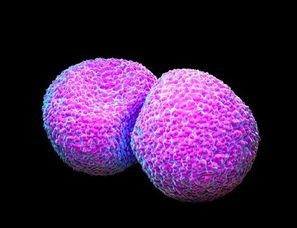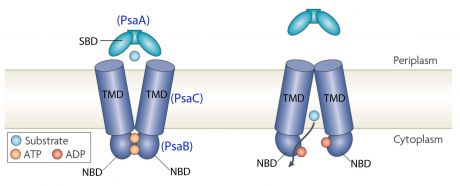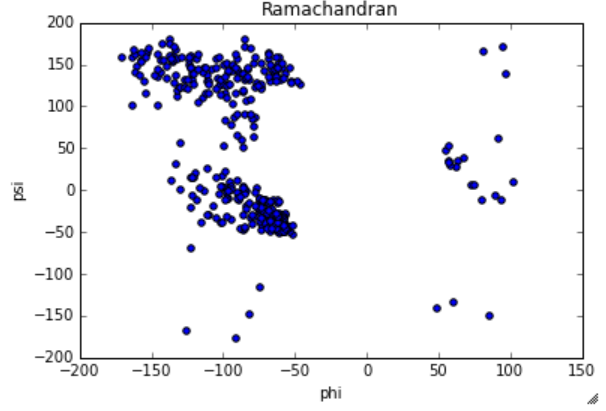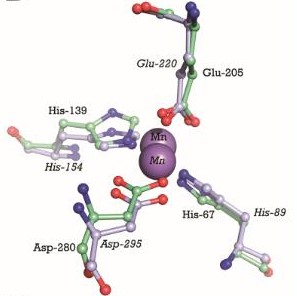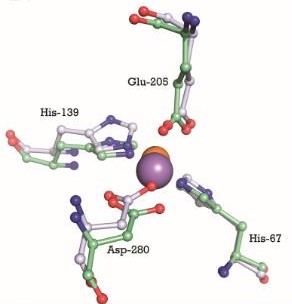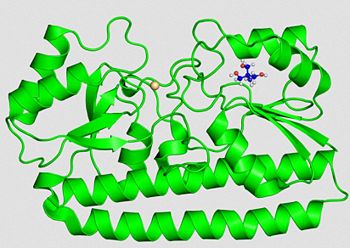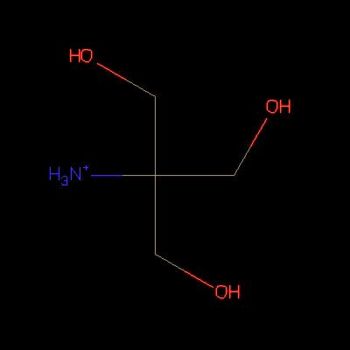Elizeu/sandbox/citocromo c
From Proteopedia
(Difference between revisions)
| Line 43: | Line 43: | ||
| - | In the case of [https://www.wikigenes.org/e/gene/e/2717000.html | + | In the case of [https://www.wikigenes.org/e/gene/e/2717000.html ''PsaA''], the ABC transporter is composed of an ATP-binding protein (PsaB), an integral membrane protein (PsaC) and PsaA itself as a lipoprotein that possess a metal-ion binding site. This confers the protein to bind divalent metal-ions, however, with a preference for Mn2+ <ref>PMID:18340341</ref>. |
The genes that encode for the components of the ABC transport system are psaA, psaB and psaC, respectively. They are organized consecutively in the psaBCA operon, together with psaD, the gene encoding for a thiol peroxidase (see below). <ref name="ref3">PMID:517531</ref>.[[Image:operon psa.jpg |500px| thumb| Psa operon <ref>PMID:15255900</ref>]] | The genes that encode for the components of the ABC transport system are psaA, psaB and psaC, respectively. They are organized consecutively in the psaBCA operon, together with psaD, the gene encoding for a thiol peroxidase (see below). <ref name="ref3">PMID:517531</ref>.[[Image:operon psa.jpg |500px| thumb| Psa operon <ref>PMID:15255900</ref>]] | ||
| Line 54: | Line 54: | ||
== Structure == | == Structure == | ||
The protein PsaA has a molecular weight of 34.538 kDa with 309 residues <ref>https://www.mybiosource.com/prods/Recombinant-Protein/Manganese-ABC-transporter-substrate-binding-lipoprotein-psaA/psaA</ref>. The overall size of the protein approximated from its crystal structure is 40 by 40 by 70 Å <ref name="ref1">PMID:28011228</ref>. | The protein PsaA has a molecular weight of 34.538 kDa with 309 residues <ref>https://www.mybiosource.com/prods/Recombinant-Protein/Manganese-ABC-transporter-substrate-binding-lipoprotein-psaA/psaA</ref>. The overall size of the protein approximated from its crystal structure is 40 by 40 by 70 Å <ref name="ref1">PMID:28011228</ref>. | ||
| - | As a member of the Lipoprotein receptor-associated antigen I (LraI) family, the PsaA molecule contains four distinct regions. An N-terminal leader sequence of 20 amino acids holds an LxACy consensus sequence that is recognized and cleaved by signal peptidase II <ref name="ref1" />. A lipid moiety (diacylglycerol <ref name="ref2">PMID:99024</ref>) is added to the cysteine residue and mediates the anchorage of the protein to the cytoplasmic membrane. Apart from this leader sequence, the rest of the protein consists of two | + | As a member of the Lipoprotein receptor-associated antigen I (LraI) family, the PsaA molecule contains four distinct regions. An N-terminal leader sequence of 20 amino acids holds an LxACy consensus sequence that is recognized and cleaved by signal peptidase II <ref name="ref1" />. A lipid moiety (diacylglycerol <ref name="ref2">PMID:99024</ref>) is added to the cysteine residue and mediates the anchorage of the protein to the cytoplasmic membrane. Apart from this leader sequence, the rest of the protein consists of two fold-pseudosymmetrical (β/α)4 sandwich domains, of which the β-strands of each domain form parallel β-sheets <ref name="ref2" />. In total the two domains form two lobes connected via an α-helical linker which constitutes the solute-binding site <ref name="ref1" />. |
'''Secondary structure of PsaA:''' | '''Secondary structure of PsaA:''' | ||
| Line 132: | Line 132: | ||
===Oxidative stress=== | ===Oxidative stress=== | ||
| - | In ''S. pneumoniae'' H2O2 and superoxides are generated as toxic derivatives of molecular oxygen in several metabolic processes and during growth by pyruvate oxidase. Subsequently, H2O2 reacts with Fe2+ during the Fenton reaction. This results in the formation of the hydroxylyl radical that causes severe damages in the cell. As a protective response against this oxidative stress, ''S. pneumoniae'' produces an Mn2+-dependent superoxide dismutase (SodA) and the thiol peroxidase encoded by ''psaD'' in the Psa operon. Due to the use of H2O2 during pneumococcal virulence these two proteins and the dependence on Mn2+ are of major importance. When Mn2+ transport is disrupted, bacterial cells display hypersensitivity towards oxidative stress <ref name="ref3" />. | + | In ''S. pneumoniae'' H2O2 and superoxides are generated as toxic derivatives of molecular oxygen in several metabolic processes and during growth by [https://en.wikipedia.org/wiki/Pyruvate_oxidase ''pyruvate oxidase'']. Subsequently, H2O2 reacts with Fe2+ during the [https://en.wikipedia.org/wiki/Fenton's_reagent ''Fenton reaction'']. This results in the formation of the hydroxylyl radical that causes severe damages in the cell. As a protective response against this oxidative stress, ''S. pneumoniae'' produces an [https://en.wikipedia.org/wiki/Superoxide_dismutase ''Mn2+-dependent superoxide dismutase''] (SodA) and the thiol peroxidase encoded by ''psaD'' in the Psa operon. Due to the use of H2O2 during pneumococcal virulence these two proteins and the dependence on Mn2+ are of major importance. When Mn2+ transport is disrupted, bacterial cells display hypersensitivity towards oxidative stress <ref name="ref3" />. |
Mn2+ enables ''Streptococcus Pneunomiae'' to have a prompt and rapid growth. Superoxides are a key player in oxidative stress generated in the presence of iron. Therefore, they inhibit growth in the absence of Mn2+. | Mn2+ enables ''Streptococcus Pneunomiae'' to have a prompt and rapid growth. Superoxides are a key player in oxidative stress generated in the presence of iron. Therefore, they inhibit growth in the absence of Mn2+. | ||
| Line 148: | Line 148: | ||
-Wzg, which regulates the capsule production and is an integral membrane regulatory protein Cps2A | -Wzg, which regulates the capsule production and is an integral membrane regulatory protein Cps2A | ||
| - | -Tpx, a thiol peroxidase with a Has antioxidant activity. This protein can remove peroxides or H2O2 by similarity. | + | -[https://www.wikigenes.org/e/gene/e/912478.html ''Tpx''], a thiol peroxidase with a Has antioxidant activity. This protein can remove peroxides or H2O2 by similarity. |
| - | -psaC, a manganese ABC transporter permease | + | -[https://www.wikigenes.org/e/gene/e/933751.html ''psaC''], a manganese ABC transporter permease |
| - | -psaB, a manganese ABC transporter ATP-binding protein. Deleting psaB results in decreased expression of PsaA. PsaC and psaC require Mn2+ supplementation for growth and transformation. | + | -[https://www.wikigenes.org/e/gene/e/933772.html ''psaB''], a manganese ABC transporter ATP-binding protein. Deleting psaB results in decreased expression of PsaA. PsaC and psaC require Mn2+ supplementation for growth and transformation. |
-SPD_1450, an iron-dependent transcriptional regulator | -SPD_1450, an iron-dependent transcriptional regulator | ||
| Line 158: | Line 158: | ||
-adcC, antibody-dependent cell-mediated cytotoxicity is a zinc ABC transporter ATP-binding protein. | -adcC, antibody-dependent cell-mediated cytotoxicity is a zinc ABC transporter ATP-binding protein. | ||
| - | -adcB, a zinc ABC transporter permease | + | -[https://www.wikigenes.org/e/gene/e/934852.html ''adcB''], a zinc ABC transporter permease |
== Disease == | == Disease == | ||
=== Otitis === | === Otitis === | ||
| - | PsaA has been recognized to be involved in the adherence and virulence mechanisms of otitis media. Streptococcus pneumoniae is one of the main agents causing bacterial acute otitis media, directly or as complication of a viral upper respiratory tract infection. This disease is a highly prevalent pediatric disease worldwide. Hearing loss is a common problem associated with this disease. Streptococcus pneumoniae in middle ear can be resistant to penicillin and cephalosporin<ref>https://www.google.com/patents/US20130078254</ref> | + | ''PsaA'' has been recognized to be involved in the adherence and virulence mechanisms of otitis media. ''Streptococcus pneumoniae'' is one of the main agents causing bacterial acute otitis media, directly or as complication of a viral upper respiratory tract infection. This disease is a highly prevalent pediatric disease worldwide. Hearing loss is a common problem associated with this disease. ''Streptococcus pneumoniae'' in middle ear can be resistant to penicillin and cephalosporin<ref>https://www.google.com/patents/US20130078254</ref> |
=== Pneumonia === | === Pneumonia === | ||
| - | PsaA protein is an adhesin which is involved in colonization of the nasopharyngeal mucosal. Moreover, alveolar pneumonia is caused by the spread of ''Streptococcus pneumoniae'' from nasopharynx. Therefore PsaA protein is involved in infection of pulmonary parenchyma by ''Streptococcus pneumoniae''. | + | PsaA protein is an [https://en.wikipedia.org/wiki/Bacterial_adhesin ''adhesin''] which is involved in colonization of the nasopharyngeal mucosal. Moreover, alveolar pneumonia is caused by the spread of ''Streptococcus pneumoniae'' from nasopharynx. Therefore PsaA protein is involved in infection of pulmonary parenchyma by ''Streptococcus pneumoniae''. |
Sometimes, ''Streptococcus pneumoniae'' pass into the blood and causes a bacteremia besides pneumonia. | Sometimes, ''Streptococcus pneumoniae'' pass into the blood and causes a bacteremia besides pneumonia. | ||
== Application in Biotechnology == | == Application in Biotechnology == | ||
| - | PsaA is being actively evaluated as a component of a vaccin in formulations composed of pneumococcal common proteins. PsaA is a component of a vaccin because this protein is immunogenic and stimulates an increase in antibody production when the nasopharynx is naturally colonized. PsaA has been expressed as an ''E.coli'' recombinant protein, purified, and evaluated in a phase one clinical trial. | + | PsaA is being actively evaluated as a component of a vaccin in formulations composed of pneumococcal common proteins. PsaA is a component of a vaccin because this protein is immunogenic and stimulates an increase in [https://en.wikipedia.org/wiki/Antibody ''antibody''] production when the nasopharynx is naturally colonized. PsaA has been expressed as an ''E.coli'' recombinant protein, purified, and evaluated in a phase one clinical trial. |
| - | Progress in vaccine development is most advanced for Streptococcus pneumoniae. Indeed, there is a seven-valent capsular-conjugate vaccine, PREVNAR® but it is rather non efficient for otitis media.<ref>PMID:11176564</ref> PsaA has been shown to be an effective vaccine in animal models at preventing Streptococcus pneumoniae infection. | + | Progress in vaccine development is most advanced for ''Streptococcus pneumoniae''. Indeed, there is a seven-valent capsular-conjugate vaccine, [https://en.wikipedia.org/wiki/Pneumococcal_conjugate_vaccine ''PREVNAR®''] but it is rather non efficient for otitis media.<ref>PMID:11176564</ref> PsaA has been shown to be an effective vaccine in animal models at preventing Streptococcus pneumoniae infection. |
==References== | ==References== | ||
<references/> | <references/> | ||
Revision as of 17:20, 27 January 2017
NCBI Accession: P42363.1
Uniprot Accesion: POA4G2
PDB ID: 3ZK7
| |||||||||||
Proteopedia Page Contributors and Editors (what is this?)
Julie Langlois, Atena Farhangian, Rebecca Holstein, Elizabeth A. Dunlap, Katherine Reynolds, Elizeu Santos, Noam Gonen, Anna Lohning, Idan Ben-Nachum, Brian Ochoa, Shai Biran, Gauri Misra, Shira Weingarten-Gabbay, Keni Vidilaseris, Jamie Costa, Abhinav Mittal, Urs Leisinger, Madison Walberry, Edmond R Atalla, Brett M. Thumm, Brooke Fenn, Joel L. Sussman, Mati Cohen, Vesta Nwankwo, Dotan Shaniv, Gulalai Shah
